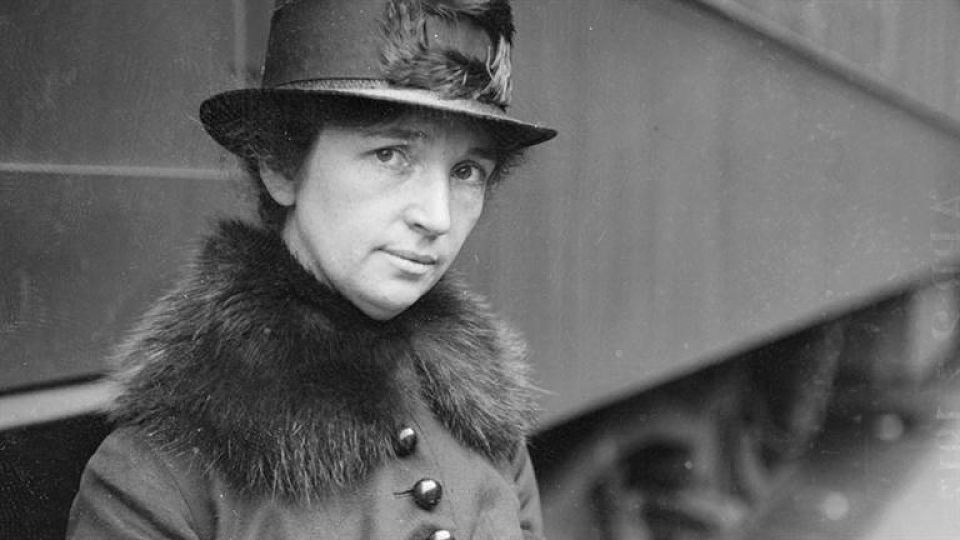“Racism and ableism do not have a place at Planned Parenthood and sure as [expletive] don’t represent the organization’s commitment to equality.” The History of 100 Years of Women’s Health Care At Planned Parenthood
“propaganda that Margaret Sanger was only interested in birth control so that she could limit the black race”¦.” Faye Wattleton, former President of Planned Parenthood
Even in the midst of controversy about what Margaret Sanger believed about eugenics and race, Planned Parenthood continues to support Sanger with no qualifiers. They even mention the “propaganda that Margaret Sanger was only interested in birth control so that she could limit the black race”¦.” Yet they fail to answer these accusations, to evaluate their merits and shortcomings.
In the following six posts, I will evaluate the merit of Planned Parenthood’s insistence that charges of racism and ableism against Margaret Sanger is pro-life propaganda by examining Sanger’s writings. If you have questions, or want to get more context, Sanger’s The Pivot of Civilization is easily accessible on Project Gutenberg. I encourage you to check it out!
Margaret Higgins Sanger had ten siblings; Margaret’s mother died from her eighteen pregnancies.[1] This experience would set the tone for Margaret’s future career. Her work as a social worker and a nurse coupled with her mother’s experiences with pregnancies convinced her of the importance of birth control, and she became a loud, outspoken birth control advocate.[2] Her pamphlets, such as “Family Limitation,” “What Every Girl Should Know,” and “What Every Mother Should Know,” informed women of birth control information and sometimes landed her in jail for violating birth control information distribution laws such as the Comstock laws. She gave speeches, put together conferences, created clinics, and founded organizations in her efforts to change the way that society viewed birth control. In her efforts, she was a “successful revolutionary.”[3]
Eugenicists refer to people who do not deserve to have children or, worse, do not deserve to live as “unfit.” Margaret Sanger had her own definition “unfit,” which encompassed a wide number and a wide variety of people. Sanger kept records of “the nationality, heredity, religion, occupation, and trade union affiliation of patients at the clinic”; it is possible that she considered all of these factors to be important in determining whether an individual was fit or not.[4] Sanger’s definition for “unfit” included racial, physical, and socioeconomic qualifications, but she focused primarily on the mentally unfit.[5] “We want, most of all, genius,” she said.[6]
Unintelligent
Throughout her book, The Pivot of Civilization, Margaret Sanger wrote that the “feeble-minded” should not have children or should be sterilized. She elaborated on the term feeble-minded on page 250, encompassing several kinds of mental problems in her definition. “Mental defect and feeble-mindedness,” she wrote, “are conceived essentially as retardation, arrest of development, differing in degree so that the victim is either an imbecile, feeble-minded or a moron, according to the relative point at which the mental development ceases.”[7] Almost anyone with a low level of intelligence or a mental handicap would fall under Sanger’s broad definition.
Sanger also understood her definition of feeble-minded, and consequently unfit, to be broadly constructed. Sanger wrote that about 10% of the U.S. population fell under her definition of “unfit.” She had a firm faith in science, and believed that it could determine who was mentally fit and who was not.[8] She cited the Mental Survey of the State of Oregon, which put 10% of Oregon’s population in the category of “feeble-minded.”[9] Sanger believed that this 10% standard not only applied to Oregon, but to the entire nation.[10] Her belief was founded on a compositional fallacy. But for Sanger, “men, women, and children who never should have been born” comprised 10% of the United States population.[11]
Race
As a eugenicist, Sanger even made eugenic distinctions based on race, though she often tried to avoid the issue.[12] She wrote of “racial mistakes.”[13] She expressed concern at the high birth rate of foreigners, just as she expressed concern at the high birth rate of the unfit and feeble-minded.[14] “Do these [foreign] elements give promise of a better stock?” she asked rhetorically.[15] She referred to Caucasian Americans as “pure white native stock.”[16] In the next sentence, she made the assumption that African Americans were at least partially responsible for the high rate of illiteracy in the South.[17] In a letter to Albert Lasker, she wrote, “I think it is magnificent that we are in on the ground floor, helping Negroes to control their birth rate.”
Poor
Orthodox eugenicists viewed the poor as inherently lacking in intelligence or character.[18] As an orthodox eugenicist, Margaret Sanger did, too. In her promotion of eugenics, she was willing to discriminate not simply by mental capacity, but by socioeconomic class. She equated the unskilled laborers with the unintelligent, which she had already labelled unfit.[19] In so doing, she added unskilled laborers to her classification of those individuals who should not have children.
Sick
Sanger’s understanding of the unfit included physical disease. In an interview with Mike Wallace, Margaret Sanger said that she believed that disease was a good reason for a couple to choose not to have children.[20] Her definition encompassed venereal, mental, and physical disease. “We must free our bodies from disease and predisposition to disease,” she wrote. “We must perfect these bodies and make them fine instruments of the mind and the spirit.”[21]
Ellen Chesler challenged many of these understandings in her book about Sanger, Woman of Valor. Chesler tried to argue that, because Sanger dismissed the idea of a cradle competition between the fit and the unfit, Sanger was not racist.[22] This argument is invalid for two reasons: the cradle competition was a competition between classes, not races; and Sanger fought against the cradle competition because she felt that preventing the unfit from having more children””through birth control, sterilization, and child labor laws””was more important than encouraging the wealthy to have more children. “The lack of balance between the birth-rate of the “˜unfit’ and “˜fit’…can never be rectified by a cradle competition between the two classes,” she wrote.[23] For Sanger, the issue of a cradle competition was not one of race, but of practicality. Sanger did not believe that encouraging the wealthy and intelligent to have more children than the poor and unintelligent was the most effective means of improving society. She instead advocated for the “elimination of the feeble-minded,” which she evidently felt was more practical and important than the proliferation of the upper classes.[24]
Chesler wrote that Margaret Sanger did not consider poverty in a eugenic light, and instead saw poverty as who had access to resources and who did not. Chesler wrote, “She framed poverty as a matter of differential access to resources, including birth control, not as the immutable consequence of low inherent ability or intelligence or character, which is the view that orthodox eugenics embraced.”[25] However, Sanger herself made a tight connection between the unintelligent and the poor. “Those of the lowest grade in intelligence are born of unskilled laborers,” she wrote.[26] Thus by suggesting that the poor are inherently unintelligent, Sanger admitted her orthodox eugenics. She did not simply adopt the modern trend; she wholeheartedly embraced eugenics.
Planned Parenthood now serves the very people Margaret Sanger considered to be “unfit,” limiting the number of children they have just as Margaret Sanger hoped to limit their families. They limit the families of the poor, the very families Sanger considered unintelligent. In their recent video, The History of 100 Years of Women’s Health Care At Planned Parenthood, the narrator says, “The organization remained committed to serving low income immigrant women.” It goes on: “Today, approximately 1 in 5 women in the U.S. visit Planned Parenthood, and ¾ of those women are low income.” The History of 100 Years of Women’s Health Care At Planned Parenthood
Planned Parenthood says that Margaret Sanger was not a racist because she opened up centers in African American communities. However, if she was seeking to limit the African American race, that is exactly what she would do. And that’s what Planned Parenthood does today: “79 percent of Planned Parenthood’s surgical abortion facilities are located within a two-mile radius, or walking distance of, a black or Hispanic neighborhood”[27] Margaret Sanger had a “Negro Project“; Planned Parenthood has “Planned Parenthood Black Community” (@PPBlackComm).
_________________________
This is the first post in a six-post discussion of Margaret Sanger. In each post, we will be examining common statements made in defense of her legacy and determine if these correspond with her writings.
[1]Alfred Rehwinkel, Planned Parenthood and Birth Control in the Light of Christian
Ethics (Saint Louis, Missouri: Concordia Publishing House, 1959), 32.
[2]Rehwinkel, 33.
[3]Wardell, Dorothy. 1980. “Margaret Sanger: Birth Control’s Successful Revolutionary.” American Journal Of Public Health 70, no. 7: 736. Academic Search Premier, EBSCOhost (accessed March 24, 2017), 736.
[4]David Kennedy, Birth Control in America: The Career of Margaret Sanger (New Haven: Yale University Press, 1971), 200.
[5]Kennedy, 115.
[6]Sanger, The Pivot of Civilization, 235.
[7]Ibid., 250.
[8]Ibid., 250.
[9]Ibid., 206.
[10]Ibid., 206.
[11]Ibid., 206.
[12]Kennedy, 117.
[13]Sanger, The Pivot of Civilization, 260.
[14]Sanger, Woman and the New Race, 34.
[15]Ibid., 33.
[16]Ibid., 38.
[17]Sanger, Woman and the New Race, 38.
[18]Ellen Chesler, Woman of Valor: Margaret Sanger and the Birth Control Movement in America (New York: Simon and Schuster Paperbacks, 2007), 484.
[19]Sanger, The Pivot of Civilization, 252.
[20]Mike Wallace and Margaret Sanger, “The Mike Wallace Interview Guest: Margaret Sanger,” Harry Ransom Center. Accessed March 14, 2017 from http://www.hrc.utexas.edu/multimedia/video/2008/wallace/sanger_margaret_t.html.
[21]Sanger, The Pivot of Civilization, 259.
[22]Chesler, 484.
[23]Sanger, The Pivot of Civilization, 187.
[24]Sanger, The Pivot of Civilization, 187.
[25]Chesler, 484.
[26]Sanger, The Pivot of Civilization, 252.
[27] http://thefederalist.com/2016/02/18/yes-planned-parenthood-targets-and-hurts-poor-black-women/

